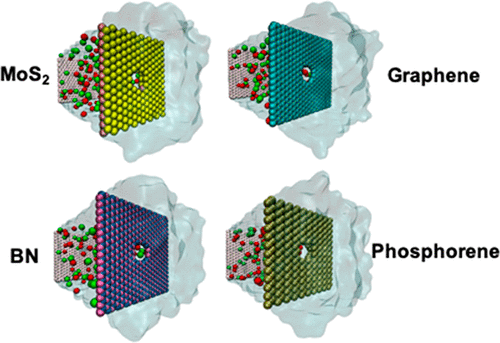当前位置:
X-MOL 学术
›
ACS Energy Lett.
›
论文详情
Our official English website, www.x-mol.net, welcomes your
feedback! (Note: you will need to create a separate account there.)
Why is Single-Layer MoS2 a More Energy Efficient Membrane for Water Desalination?
ACS Energy Letters ( IF 19.3 ) Pub Date : 2020-06-01 , DOI: 10.1021/acsenergylett.0c00923 Zhonglin Cao 1 , Vincent Liu 1 , Amir Barati Farimani 1
ACS Energy Letters ( IF 19.3 ) Pub Date : 2020-06-01 , DOI: 10.1021/acsenergylett.0c00923 Zhonglin Cao 1 , Vincent Liu 1 , Amir Barati Farimani 1
Affiliation

|
Water desalination technologies are extensively utilized to solve water scarcity problems in many regions of the world. Discovery and application of two-dimensional (2D) nanoporous materials provide engineers a viable solution for reducing to a large extent energy consumption during the water desalination process. In this work, we conducted a thorough comparison of the water permeability and ion rejection rate between various 2D materials, including MoS2, graphene, phosphorene, boron nitride, and MoSe2. Through molecular dynamics simulation, we demonstrated that among all 2D materials with the same pore size, single-layer MoS2 consistently performs 27% better than graphene, 38% than phosphorene, 35% than BN, and 20% than MoSe2 in terms of water permeability while maintaining a greater than 99% ion rejection rate. We further investigated how the fundamental physics behind the outstanding performance of MoS2 is a combination of water structure and dynamics near the membrane surface, energy barrier, and water packing and velocity inside the nanopore.
中文翻译:

为什么单层MoS 2成为用于海水淡化的更节能的膜?
水淡化技术被广泛用于解决世界许多地区的水资源短缺问题。二维(2D)纳米多孔材料的发现和应用为工程师提供了一种可行的解决方案,可在很大程度上降低水淡化过程中的能耗。在这项工作中,我们对各种2D材料(包括MoS 2,石墨烯,磷烯,氮化硼和MoSe 2)之间的透水性和离子排斥率进行了彻底的比较。通过分子动力学模拟,我们证明了在所有具有相同孔径的2D材料中,单层MoS 2始终比石墨烯好27%,比磷好38%,比BN好35%和比MoSe 2好20%在水渗透率方面,同时保持大于99%的离子排斥率。我们进一步研究了MoS 2出色性能背后的基本物理原理是如何将水结构和膜表面附近的动力学,能垒以及水的堆积和纳米孔内部的速度结合在一起。
更新日期:2020-07-10
中文翻译:

为什么单层MoS 2成为用于海水淡化的更节能的膜?
水淡化技术被广泛用于解决世界许多地区的水资源短缺问题。二维(2D)纳米多孔材料的发现和应用为工程师提供了一种可行的解决方案,可在很大程度上降低水淡化过程中的能耗。在这项工作中,我们对各种2D材料(包括MoS 2,石墨烯,磷烯,氮化硼和MoSe 2)之间的透水性和离子排斥率进行了彻底的比较。通过分子动力学模拟,我们证明了在所有具有相同孔径的2D材料中,单层MoS 2始终比石墨烯好27%,比磷好38%,比BN好35%和比MoSe 2好20%在水渗透率方面,同时保持大于99%的离子排斥率。我们进一步研究了MoS 2出色性能背后的基本物理原理是如何将水结构和膜表面附近的动力学,能垒以及水的堆积和纳米孔内部的速度结合在一起。




















































 京公网安备 11010802027423号
京公网安备 11010802027423号